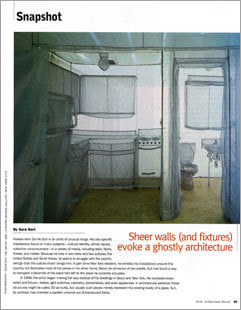
Snapshot
By Sara Hart
Korean-born Do-Ho Suh is an artist of unusual range. His site-specific installations focus on many subjects - cultural identity, ethnic values, collective consciousness - in a variety of media, including resin, fabric, thread, and rubber. Because he lives in two cities and two cultures, the United States and South Korea, he seems to struggle with the psychic vertigo that the culture shock brings him. A part-time New York resident, he exhibits his installations around this country but fabricates most of the pieces in his other home, Seoul. As someone of two worlds, Suh has found a way to transport a facsimile of the place he's left to the place he currently occupies.
In 1999, the artist began making full-size replicas of his dwellings in Seoul and New York. He recreated every detail and fixture - toilets, light switches, cabinetry, bookshelves, and even appliances. In architectural parlance, these structures might be called 3D as-builts, but usually such pieces merely represent the existing reality of a place. Suh, by contrast, has invented a parallel universe out of translucent fabric.
West 22nd St., Apt. A (2001) is the full-scale replica of Suh's apartment in Manhattan's Chelsea neighborhood. First, he measured and recorded the entire place. Then he devised sewing patterns, from which seamstresses in Seoul fabricated every element in the apartment out of gray nylon.
The experience is not unlike some dream sequence in which reality - in this case, the reality of structure, material, and texture - has been drained, leaving only a gauzy, ghostly memory. Some visitors, especially architects, will find Apt. A's interiors limp, sad, and vulnerable. Others will simply immerse themselves in the hallucination. Fortunately, the floor retains its solidity and strength, grounding the experience and reminding visitors that the dream is, in fact, an art installation. The work remains an intellectual commen-tary on the psychological comfort of familiarity.
Suh's other similar investigations are perhaps more sensual and less haunting. He also stitched a likeness of his childhood home in Seoul in green silk organza and made Staircase (2003), a red nylon interpretation of 348 West 22nd Street's stair, cur-rently on view at the Arthur M. Sackler Gallery in Washington, D.C. (through September 26). Staircase dangles from the ceiling, hovering inches above the floor. It is more sculptural than spatial, which by com-parison makes Apt. A all the more visceral.
